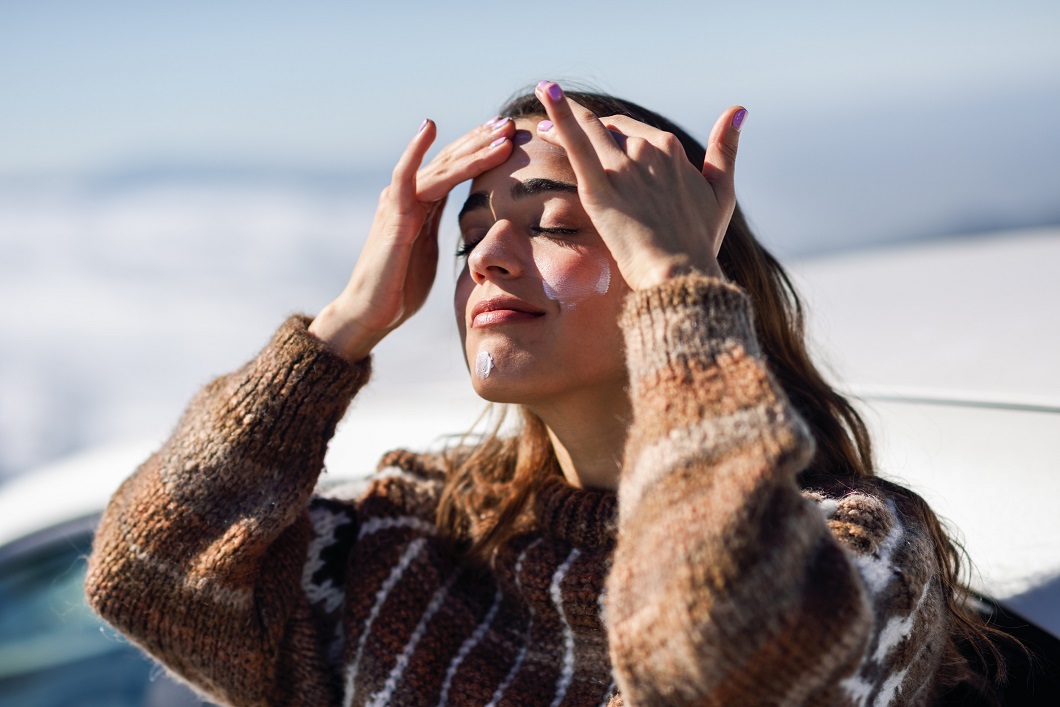Protect Your Skin From the Sun, Even in Winter
December 18, 2024While warm temperatures are on hold for a bit, it is still essential to wear sunscreen in the cold-weather months.
Reasons to Wear Sunscreen in the Winter
Wearing sunscreen in the winter is important for several reasons, even though the weather may seem less intense than in the summer. Here are the key reasons to continue using sunscreen during colder months:
1. UV Radiation is Present Year-Round
UV rays (both UVA and UVB) are present all year long, even on cloudy or snowy days. UVA rays, which contribute to skin aging and cancer, can penetrate through clouds and windows.
2. Snow Reflects UV Rays
Snow can reflect up to 80% of UV rays, intensifying exposure, especially in snowy environments like mountains. This increases the risk of sunburns on the face, neck, and other exposed skin areas.
3. Higher Altitudes Have More Intense UV Exposure
If you're in a mountainous region, UV rays are stronger at higher altitudes, increasing the potential for sunburn, even in winter. For every 1,000 feet you ascend, UV intensity increases by about 5%.
4. Winter Sports Increase Risk
Activities such as skiing, snowboarding, or ice skating often take place outdoors, where the combination of sunlight and snow reflection can lead to higher exposure.
5. Protection from Skin Damage
UV exposure can damage skin over time, leading to premature aging (wrinkles, spots, and loss of elasticity) and increasing the risk of skin cancer. Regular sunscreen use helps protect your skin from this long-term harm.
6. Winter Sunburns are Real
While winter sunburns are less common than summer ones, they still happen. The cold air can mask the effects of the sun, so you might not feel burned immediately, leading to delayed damage.
7. Winter Skin Is More Vulnerable
Cold, dry winter air can already leave skin more sensitive and prone to irritation. Adding UV protection helps prevent further damage.
For maximum protection, it's important to choose a broad-spectrum sunscreen (protecting against both UVA and UVB rays) with an SPF of at least 30, and reapply as needed.
Regular Skin Checks
It’s also important to regularly check your skin for any changes or abnormalities.
When evaluating any skin changes you happen to find, use the ABCDE rule:
Asymmetry. Unlike a regular, oval or round mole, one half of a melanoma lesion doesn’t look like the other half.
Borders. Most melanomas have jagged or other uneven borders.
Color. Melanomas may be more than one color, such as brown, tan, white, pink or red.
Diameter. Most melanomas are about the size of a pencil eraser, though they can be smaller.
Evolving. This is when a mole or spot changes in size, shape or color.
If you notice any of these changes, make an appointment with your primary care provider as soon as possible.
Find a primary care provider at RiversideHealthcare.org/primarycare.
Common Types of Skin Cancer
There are several types of skin cancer, each varying in terms of appearance, severity, and treatment options. The three most common types are:
Basal Cell Carcinoma (BCC)
Basal cell carcinoma is the most common form of skin cancer, accounting for about 80% of skin cancer cases. It starts in the basal cells, which are located in the deepest layer of the epidermis (the outer layer of skin).z
BCC usually appears as a small, shiny, or pearly bump or a flat, scaly patch. It may be pink, red, or white and can bleed or develop a crust. Sun exposure, fair skin, older age, and a history of sunburns increase the risk. BCC grows slowly and rarely spreads (metastasizes) to other parts of the body, but it can damage surrounding tissues if untreated.
Squamous Cell Carcinoma (SCC)
Squamous cell carcinoma is the second most common type of skin cancer, accounting for about 16% of skin cancer cases. It begins in the squamous cells, which are the flat cells found in the outer layer of the skin.
SCC often looks like a red, scaly, or crusted patch, ulcer, or wart-like growth. It may be raised and bleed. Like BCC, SCC is associated with sun exposure, but also with factors such as a weakened immune system, smoking, and certain genetic conditions.
SCC can spread to nearby lymph nodes and other parts of the body if not treated early, but when detected early, it's generally treatable.
Melanoma
Melanoma is the most dangerous form of skin cancer. It accounts for a smaller proportion of skin cancer cases but is responsible for most skin cancer deaths. Melanoma develops in melanocytes, the pigment-producing cells in the skin.
It typically appears as a dark brown or black mole or growth, but can also be other colors (red, blue, or white). It may have irregular borders and asymmetry. UV exposure, having many moles or atypical moles, fair skin, family history, and a history of sunburns or tanning bed use increase the risk.
Melanoma can spread quickly to other parts of the body (metastasize), making early detection and treatment crucial for a positive outcome.
The Riverside Cancer Institute treats skin cancer among dozens of types of cancer. For more information, go to riversidehealthcare.org/services/cancer-institute.

